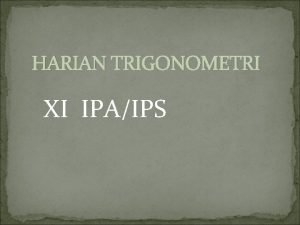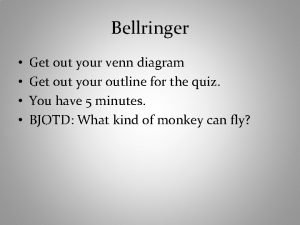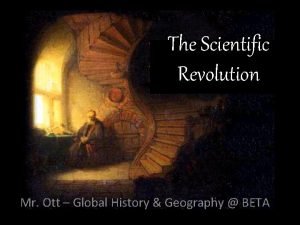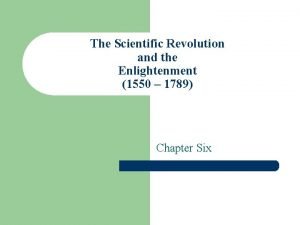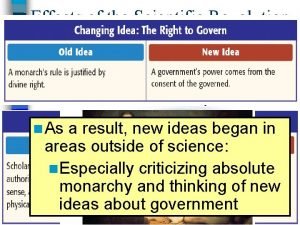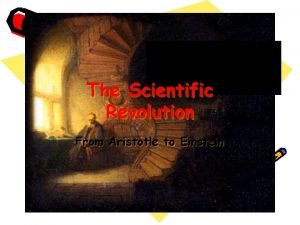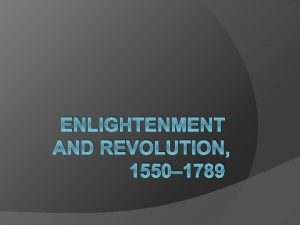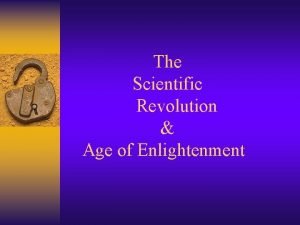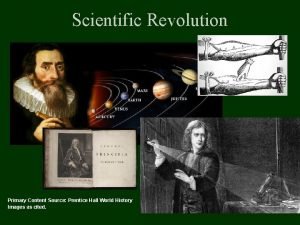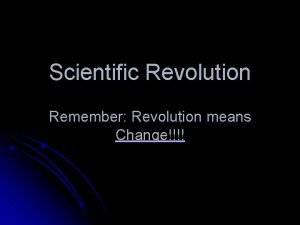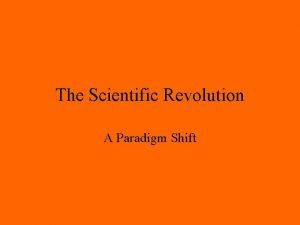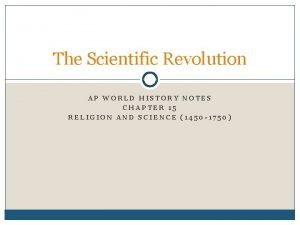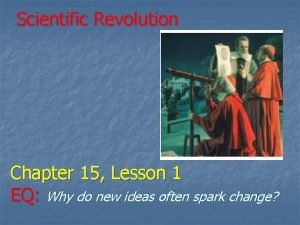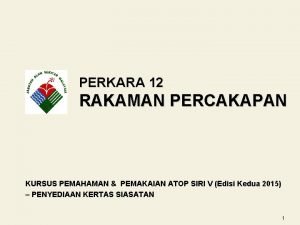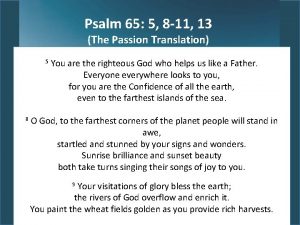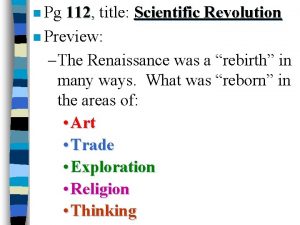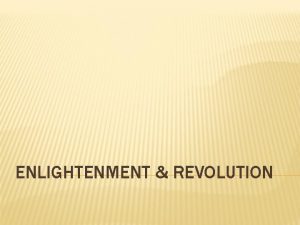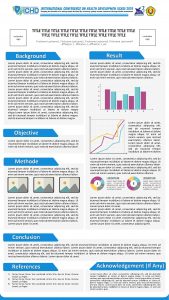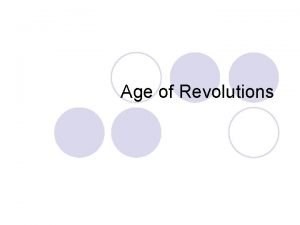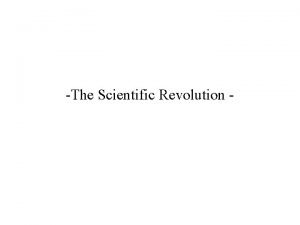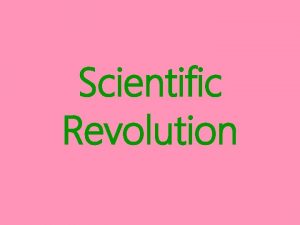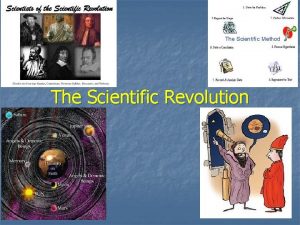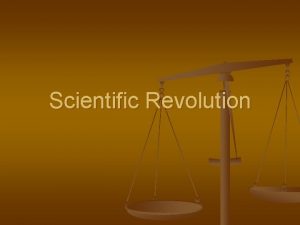n Pg 112 112 title Scientific Revolution n




























- Slides: 28

n Pg 112, 112 title: Scientific Revolution n Preview: – The Renaissance was a “rebirth” in many ways. What was “reborn” in the areas of: • Art • Trade • Exploration • Religion • Thinking

Scientific Revolution—a movement in the 1600 s in which new technology and innovative approaches to seeking knowledge led to a breakthrough in European thought. (Everything was questioned; nothing was assumed)

Complete Flow Chart on the Scientific Breakthroughs

Scientific Revolution

n. Scientific Revolution—a movement in the 1600 s in which new technology and innovative approaches to seeking knowledge led to a breakthrough in European thought. (Everything was questioned; nothing was assumed)

Logic n During the Scientific Revolution, logic (reasoning) were utilize as tools to find truth; Logic—using the mind and science to determine answers n How did people come up with answers before Scientific Revolution? – Magical Thought (witch did it) – Religious Thought (god did it) – Scientific Thought (using logic)

Deductive Reasoning n Observing something general & using logic to prove a hypothesis (unproven question) n Use Scientific Method to prove hypothesis –Premise: All dogs have four legs –Premise: Rover is a dog –Conclusion: Rover has four legs

Scientific Method n Theory—Observation of something in nature n Form Hypothesis—come up with a question about observation n Experimentation—conduct tests to determine answers to hypothesis n Confirmation—analyze & interpret data to see if hypothesis is true

n Observing Inductive Reason something specific & using logic to make a general statement –Observation: John came to class late this morning –Observation: John’s hair was uncombed –Prior experience: John is very fussy about his hair –Conclusion: John overslept

Reasons for Scientific Revolution n Renaissance—emphasis on order, perfection, its OK to question traditional beliefs, humans can accomplish anything n Reformation—Catholic Church did not always support scientific thought; new religions weakened Church authority n Overseas Exploration—caused scientific research on new plants & animals brought back

William Harvey

William Harvey n English doctor and teacher--first to correctly describe and prove that blood circulates through the body & pumped by the heart n Provided important understanding of how body works

Andreas Vesalius

Andreas Vesalius n Brought innovation to study of human anatomy for first time in more than 1, 500 years n Scientific knowledge is found by observing nature (not reading books) n Recorded first collection of scientific observation since ancient times n Marked beginning of modern science


Nicolaus Copernicus

Nicolaus Copernicus n Founder of modern astronomy n Introduced heliocentric hypothesis: earth is 1 of many heavenly bodies that spin on their axes & revolve around the sun n Revolutionized Europe’s concept of the universe n Influenced: Galileo, Kepler, & Newton

Galileo Galilei

Galileo Galilei n Considered one of most influential scientists in history n Law of Inertia, invented telescope, astronomy observations n Perfection of scientific method-emphasis on careful, quantitative measurements

Isaac Newton

Isaac Newton n The greatest and most influential scientist of the era n Major contributions to understanding of motion, light, heat n Discovered theory of gravity n Created calculus

Johannes Kepler

Johannes Kepler n Astronomer and mathematician who mathematically proved Copernicus’ theory about planetary movements n Planets move in ellipses & do not always travel at same speed around the sun

Rene Descartes

Rene Descartes n Philosopher & Mathematician who believed truth is found only in logic n Searched for knowledge in everything—went through entire life questioning the existence of everything (except that he was alive) & did not trust anything to be true until he proved it (“I think, therefore I am”)

Benjamin Franklin

Benjamin Franklin n Made important discoveries in electricity and meteorology n Invented bifocals, odometer, & lightening rod

1 2 3 4 5 6 7 n On pg 108, 108 below Preview complete the following Review assignment: n Rank order the most important Scientists during the Scientific Revolution. Under each person write a 1 sentence justification that explains why each scientist was placed where he was on the continuum
 Sin 112
Sin 112 Modern commercial agriculture
Modern commercial agriculture Russian revolution vs french revolution
Russian revolution vs french revolution How could the french revolution have been avoided
How could the french revolution have been avoided Scientific revolution and enlightenment speed dating
Scientific revolution and enlightenment speed dating Scientific revolution effects on society
Scientific revolution effects on society Newton's first law of motion
Newton's first law of motion Scientific revolution effects
Scientific revolution effects Enlightenment vs scientific revolution
Enlightenment vs scientific revolution What did isaac newton do in the scientific revolution
What did isaac newton do in the scientific revolution Newton's first law of motion
Newton's first law of motion Galileo galilei prezi
Galileo galilei prezi How did the reformation help spur the scientific revolution
How did the reformation help spur the scientific revolution Scientific revolution and enlightenment speed dating
Scientific revolution and enlightenment speed dating Chapter 6 section 1 the scientific revolution
Chapter 6 section 1 the scientific revolution Causes of scientific revolution
Causes of scientific revolution Scientific revolution primary sources
Scientific revolution primary sources Causes of scientific revolution
Causes of scientific revolution Scientific revolution effects
Scientific revolution effects Scientific revolution ap world history
Scientific revolution ap world history Why do new ideas often spark change?
Why do new ideas often spark change? Lesson 1 the scientific revolution answer key
Lesson 1 the scientific revolution answer key Title title
Title title Prefatory part of report
Prefatory part of report Scientific inquiry vs scientific method
Scientific inquiry vs scientific method How is a scientific law different from a scientific theory?
How is a scientific law different from a scientific theory? Hechos 2 112
Hechos 2 112 Etika percakapan
Etika percakapan 65 5
65 5
